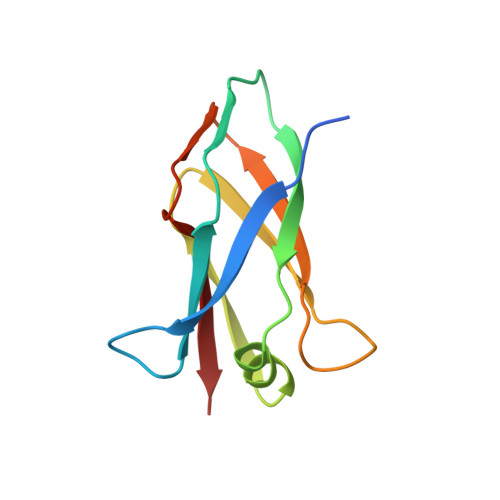Molecular structure of a proteolytic fragment of TLP20.
Holden, H.M., Wesenberg, G., Raynes, D.A., Hartshorne, D.J., Guerriero, V., Rayment, I.(1996) Acta Crystallogr D Biol Crystallogr 52: 1153-1160
- PubMed: 15299576
- DOI: https://doi.org/10.1107/S0907444996008128
- Primary Citation of Related Structures:
1TUL - PubMed Abstract:
Myosin light-chain kinase is responsible for the phosphorylation of myosin in smooth muscle cells. In some tissue types, the C-terminal portion of this large enzyme is expressed as an independent protein and has been given the name telokin. Recently, an antibody directed against telokin was found to interact with a protein derived from the baculovirus Autographa californica nuclear polyhedrosis virus. This protein was biochemically characterized and given the name TLP20 for telokin-like protein of 20 000 molecular weight. The amino-acid sequence of TLP20 was determined on the basis of a cDNA clone and subsequent alignment searches failed to reveal any homology to telokin or to other known proteins. The three-dimensional structure of a proteolytic portion of TLP20 is reported here. Crystals employed in the investigation were grown from ammonium sulfate solutions at pH 6.0 and belonged to the space group P2(1)3 with unit-cell dimensions of a = b = c = 76.3 A and one molecule per asymmetric unit. The structure was determined by multiple isomorphous replacement with three heavy-atom derivatives. Least-squares refinement of the model reduced the crystallographic R factor to 18.1% for all measured X-ray data from 30.0 to 2.2 A. The overall fold of the molecule may be described as a seven-stranded antiparallel beta-barrel flanked on the bottom by two additional beta-strands and on the top by an alpha-helix. Quite surprisingly, the three-dimensional structure of this beta-barrel is not similar to telokin or to any other known protein.
Organizational Affiliation:
Institute for Enzyme Research, Graduate School and Department of Biochemistry, University of Wisconsin, Madison 53705, USA.














